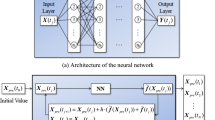The purpose of this work is to establish an effective prediction of the spring-back of material during the processing of an L-shaped bend. FEM-simulation of an L-shaped bend is carried out for various thicknesses of material, various punch-round-radii and die-round-radii. The spring-back depends on the shape of the bend-die and the mechanical properties of the material. The results of spring-back from FEM-simulation are then input to a neural network to establish a model for the L-shaped bend variables. The neural network is composed of a number of functional nodes. Once the L-shaped bend para-meters (material thickness, punch-round-radius and die-round-radius) are given, the bend processing performance (spring-back) can be accurately predicted by this developed network. A simulation annealing (SA) optimisation algorithm with a performance index to obtain a perfect L-shape can search for the optimal bend processing parameters. A satisfactory result was achieved based on a demonstration of simulation and on practical experience, showing that this is a new and feasible approach for use in the control of spring-back of materials.
Similar content being viewed by others
Author information
Authors and Affiliations
Rights and permissions
About this article
Cite this article
Lin, J., Tai, C. The Application of Neural Networks in the Prediction of Spring-back in an L-Shaped Bend. Int J Adv Manuf Technol 15, 163–170 (1999). https://doi.org/10.1007/s001700050053
Issue Date:
DOI: https://doi.org/10.1007/s001700050053




